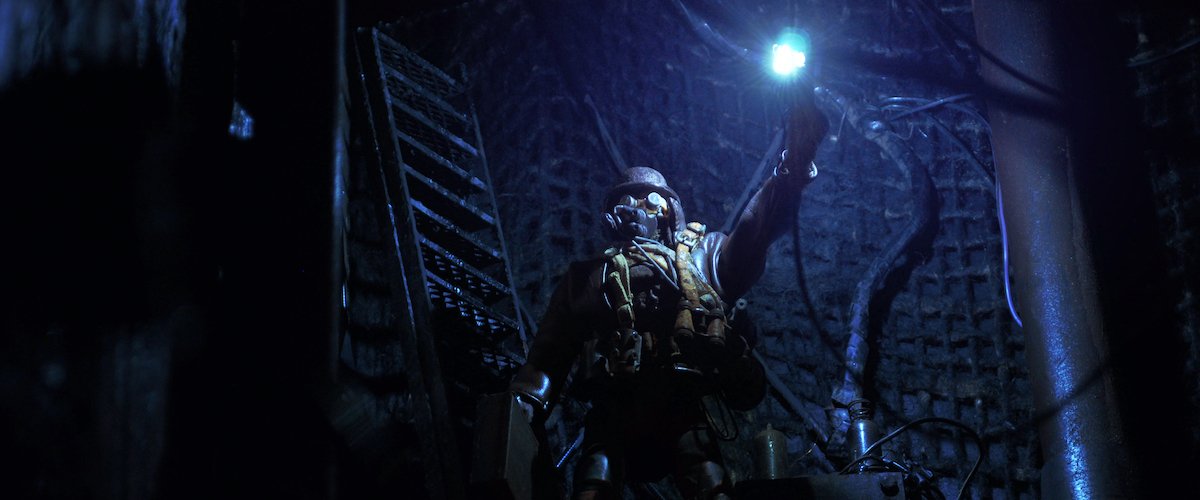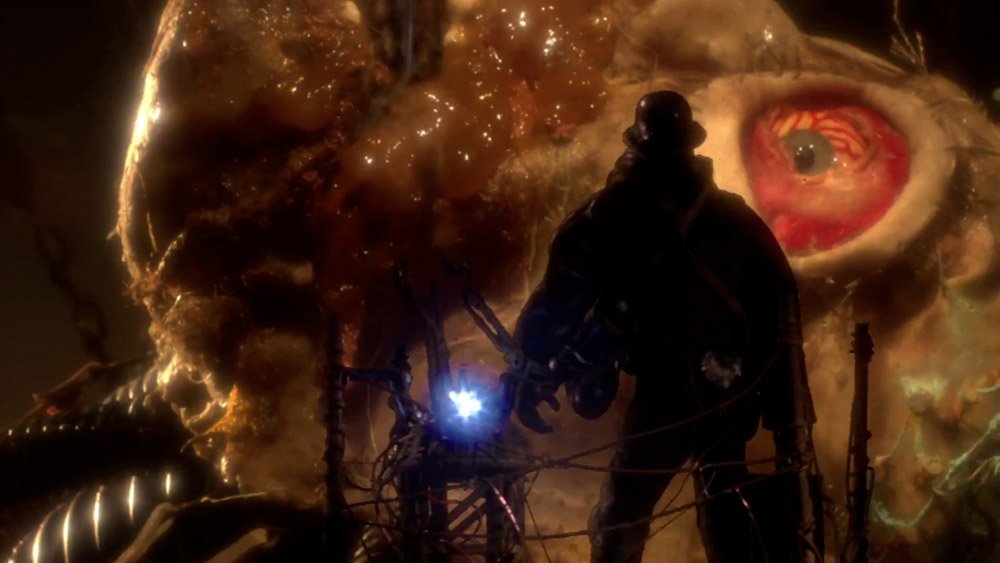[Film Review] Mad God (2021)

Mad God is a bleak, visually arresting journey into a world of madness, suffering and violence, filled with ‘Miltonesque’ monsters and villains. It follows The Assassin on his journey through a hellish landscape filled with nightmarish characters to plant a bomb behind enemy lines, and bear witness to the chaos he observes on his quest into a netherworld of horror.
In The Assassin we see an objective observer, who watches the various atrocities that take place in this subterranean hellscape, but doesn't intervene. This notion of objectivity, and of a lack of action is quite literally reflected throughout the film, where the character’s glasses are used as mirrors to reflect the horrors they witness back to the viewer. It acts as a stark reminder about the desire to look away, something we all indulge in. Due to the lack of dialogue, we are left to ponder on his purpose and indeed his motivations, as we are for all the characters included in the film, adding an interesting air of ambiguity. Indeed, this is a film that will divide audiences, it is surreal and strange, with elements of the grotesque throughout, and there is a lack of driving narrative that some viewers may find frustrating. But it’s worth it, if not only to see the sheer amount of work that has gone into the creation of the world The Assassin wanders through. It’s a treat for the eyes, and a loving homage to the art of stop-motion animation.

The imagery in Mad God is so surreal, so strangely affecting, that interpretations abound about what it may all mean. For me, it seemed that much of the film appears as an allegory for capitalism, with strange wire wool beings made solely to labour then be destroyed. Tippett also heavily references the role of fate, place and time, with the idea that some people are just set up to be felled early, whereas others have a different purpose. This pulls from various cultures and traditions, but I particularly enjoyed the three witches aspect, seeing them as a representation of that great tradition of The Fates, sewing together a map of life for the Assassin to follow. It’s also possible that this is a stop-animation interpretation of hell, seen through the Assassin’s eyes as his rusted, crumbling diving bell sinks deeper into the abyss, and indeed the film’s own creators have referenced Milton in their synopsis, making it easy to draw the comparison. We see war, capitalism and a visceral symbiotic relationship, in which everything is cyclical and feeds everything else. This adds a complexity to the narrative and reminds the viewer that all these facets of society are interwoven, making a profound statement about the world we live in. It may appear at odds with the misshapen, fantastical world The Assassin travels through, but when examined more closely the allegorical nature of Mad God shouldn’t be dismissed so readily. There is such texture to Mad God, everything's sweaty, squelching, bloody and gross. You feel the voltage from the sparking wires, the heat from furnaces, imagining you can smell the stench of death and dripping walls. It has the vibe of post-apocalyptic steampunk and it is an assault on the senses from start to grim finish.

To watch Mad God is to experience it, and I can’t say that it’s a film you would stick on one Friday night when you wanted to have a laugh and unwind. But there is a grisly majesty to it, one that is only further emphasised when you reflect on the fact that everything is handmade and it is filmed using that tortuously long (but worth it!) process of stop-animation. As all the promotion for the film reminds us, this is a project thirty years in the making, and it shows. There is a real sense of writer/producer/director Phil Tippett’s craft here, known for work on Robocop and Jurassic Park and passion for this style of filmmaking. It is clear that this is a labour of love, as well as a chance to spew forth all the dark and morbid thoughts that lurk within the human psyche. The style of the film is refreshingly distinct and there is a clear sense of tone throughout. That the tone is one of evisceration, torture and spindly terrors that lurk in the shadows is what makes it a fitting addition to Shudder’s catalogue.

RELATED ARTICLES
When V/H/S first hit our screens in 2012, nobody could have foreseen that 11 years later we’d be on our sixth instalment (excluding the two spinoffs) of the series.
When someone is in a toxic relationship, it can affect more than just their heart and mind. Their bodies can weaken or change due to the continued stress and unhappiness that comes from the toxicity.
If you can’t count on your best friend to check your teeth and hands and stand vigil with you all night to make sure you don’t wolf out, who can you count on? And so begins our story on anything but an ordinary night in 1993…
The best thing about urban legends is the delicious thrill of the forbidden. Don’t say “Bloody Mary” in the mirror three times in a dark room unless you’re brave enough to summon her. Don’t flash your headlights at a car unless you want to have them drive you to your death.
A Wounded Fawn (Travis Stevens, 2022) celebrates both art history and female rage in this surreal take on the slasher genre.
Perpetrator opens with a girl walking alone in the dark. Her hair is long and loose just begging to be yanked back and her bright clothes—a blood red coat, in fact—is a literal matador’s cape for anything that lies beyond the beam of her phone screen.
Filmed on location in Scotland, Ryan Hendrick's new thriller Mercy Falls (2023) uses soaring views of the Scottish Highlands to show that the natural world can either provide shelter or be used as a demented playground for people to hurt each other.

EXPLORE
Now it’s time for Soho’s main 2023 event, which is presented over two weekends: a live film festival at the Whirled Cinema in Brixton, London, and an online festival a week later. Both have very rich and varied programmes (with no overlap this year), with something for every horror fan.
In the six years since its release the Nintendo Switch has amassed an extensive catalogue of games, with everything from puzzle platformer games to cute farming sims to, uh, whatever Waifu Uncovered is.
A Quiet Place (2018) opens 89 days after a race of extremely sound-sensitive creatures show up on Earth, perhaps from an exterritorial source. If you make any noise, even the slightest sound, you’re likely to be pounced upon by these extremely strong and staggeringly fast creatures and suffer a brutal death.
If you like cults, sacrificial parties, and lesbian undertones then Mona Awad’s Bunny is the book for you. Samantha, a student at a prestigious art university, feels isolated from her cliquey classmates, ‘the bunnies’.
The slasher sub genre has always been huge in the world of horror, but after the ‘70s and ‘80s introduced classic characters like Freddy Krueger, Michael Myers, Leatherface, and Jason, it’s not harsh to say that the ‘90s was slightly lacking in the icon department.
Mother is God in the eyes of a child, and it seems God has abandoned the town of Silent Hill. Silent Hill is not a place you want to visit.
Being able to see into the future or back into the past is a superpower that a lot of us would like to have. And while it may seem cool, in horror movies it usually involves characters being sucked into terrifying situations as they try to save themselves or other people with the information they’ve gleaned in their visions.
Both the original Pet Sematary (1989) and its 2019 remake are stories about the way death and grief can affect people in different ways. And while the films centre on Louis Creed and his increasingly terrible decision-making process, there’s no doubt that the story wouldn’t pack the same punch or make the same sense without his wife, Rachel.


![[Film Review] V/H/S/85 (2023)](https://images.squarespace-cdn.com/content/v1/5fe76a518d20536a3fbd7246/1697455043249-K64FG0QFAFVOMFHFSECM/MV5BMDVkYmNlNDMtNGQwMS00OThjLTlhZjctZWQ5MzFkZWQxNjY3XkEyXkFqcGdeQXVyMTUzMTg2ODkz._V1_.jpg)
![[Film Review] Kill Your Lover (2023)](https://images.squarespace-cdn.com/content/v1/5fe76a518d20536a3fbd7246/1697465940337-T55VQJWAN4CHHJMXLK32/56_PAIGE_GILMOUR_DAKOTA_HALLWAY_CONFRONTATION.png)
![[Film Review] Shaky Shivers (2022)](https://images.squarespace-cdn.com/content/v1/5fe76a518d20536a3fbd7246/1696442594997-XMJSOKZ9G63TBO8QW47O/Screenshot+2023-10-04+at+18.59.33.png)
![[Film Review] Elevator Game (2023)](https://images.squarespace-cdn.com/content/v1/5fe76a518d20536a3fbd7246/1696440997551-MEV0YZSC7A7GW4UXM5FT/Screenshot+2023-10-04+at+18.31.42.png)
![[Film Review] A Wounded Fawn (2022)](https://images.squarespace-cdn.com/content/v1/5fe76a518d20536a3fbd7246/1695484054446-7R9YKPA0L5ZBHJH4M8BL/Screenshot+2023-09-23+at+16.42.24.png)
![[Film Review] Perpetrator (2023)](https://images.squarespace-cdn.com/content/v1/5fe76a518d20536a3fbd7246/1695483561785-VT1MZOMRR7Z1HJODF6H0/Screenshot+2023-09-23+at+16.32.55.png)
![[Film Review] Mercy Falls (2023)](https://images.squarespace-cdn.com/content/v1/5fe76a518d20536a3fbd7246/1695482997293-E97CW9IABZHT2CPWAJRP/Screenshot+2023-09-23+at+16.27.27.png)





















![[Editorial] 10 Films & Events to Catch at Soho Horror Film Fest 2023](https://images.squarespace-cdn.com/content/v1/5fe76a518d20536a3fbd7246/1700819417135-299R7L4P0B676AD3RO1X/Screenshot+2023-11-24+at+09.41.52.png)
![[Editorial] 9 Horror Nintendo Switch Games To Play](https://images.squarespace-cdn.com/content/v1/5fe76a518d20536a3fbd7246/1697214470057-3XZXX8N4LYIMDFWS6Z3P/Screenshot+2023-10-13+at+17.20.13.png)
![[Mother of Fears] Mothering in Silence in A Quiet Place (2018)](https://images.squarespace-cdn.com/content/v1/5fe76a518d20536a3fbd7246/1696445921315-HZJ2DZYQIH6VVWXBO2YL/Screenshot+2023-10-04+at+19.52.29.png)
![[Editorial] 5 Female Focused Horror Book Recommendations](https://images.squarespace-cdn.com/content/v1/5fe76a518d20536a3fbd7246/1696441981361-52EQCTJ7AT2QF1927GM7/919xtm6d3fL._AC_UF894%2C1000_QL80_.jpg)
![[Editorial] 9 Best Slashers Released Within 10 Years of Scream (1996)](https://images.squarespace-cdn.com/content/v1/5fe76a518d20536a3fbd7246/1695478839037-LOFHGVM3H6BMSZW7G83M/Screenshot+2023-09-23+at+15.15.11.png)
![[Mother of Fears] Mother Vs. Monster in Silent Hill (2006)](https://images.squarespace-cdn.com/content/v1/5fe76a518d20536a3fbd7246/1695485781119-H6GNP0G3J2TLPAOIABV7/Screenshot+2023-09-23+at+17.11.56.png)
![[Editorial] 9 Terrifying Cerebral Visions in Horror Movies](https://images.squarespace-cdn.com/content/v1/5fe76a518d20536a3fbd7246/1693509801235-X23OL50T1DVGECH0ZJK2/MV5BMjQ0MTg2MjQ4MV5BMl5BanBnXkFtZTgwMTU3NDgxMTI%40._V1_.jpg)
![[Mother of Fears] I Don’t Wanna Be Buried in a Pet Sematary (1989) and (2019)](https://images.squarespace-cdn.com/content/v1/5fe76a518d20536a3fbd7246/1691328766069-QFNAVJOMFZVZ5CLU1RWM/Screenshot+2023-08-06+at+14.23.13.png)

If you know me at all, you know that I love, as many people do, the work of Nic Cage. Live by the Cage, die by the Cage. So, when the opportunity to review this came up, I jumped at it.